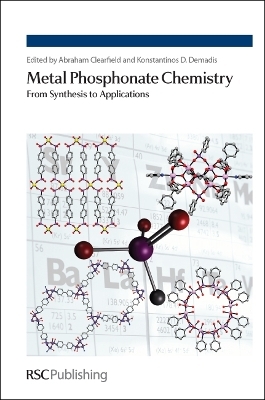
Metal Phosphonate Chemistry
Royal Society of Chemistry (Verlag)
978-1-84973-356-4 (ISBN)
Metal phosphonate chemistry is a highly interdisciplinary field, as it encompasses several other areas, such as materials chemistry, gas storage, pharmaceutics, corrosion control, classical chemical synthesis, X-Ray crystallography, powder diffraction, etc. It has also acquired additional significance due to "Metal-Organic Frameworks", as evidenced by the hundreds of papers published each year. Currently there is no other book on the topic and this book fills the gap in the literature by summarising in a concise way the latest developments in the field. Metal phosphonate chemistry has seen impressive growth in the last 15-20 years and there is a clear need to systematize and organize all this growth. This unique book accomplishes just that need - edited by two experts, it includes contributions from other experienced researchers and organises, cateqorises and presents in an attractive way the latest hot topics in metal phosphonate chemistry and related applications. With an extensive bibliography, it is a great reference for academic and industrial researchers as well as students working in the field and will act as a starting point for further exploration of the literature. It is also of great interest to scientists working in the broader area of metal-organic frameworks and their applications.
Abraham Clearfield's research interests are focused on solid state and materials chemistry and encompass a wide variety of projects. An important goal is the ability to design and synthesize new materials whose structure and properties can be predicted and controlled. Layered compounds are amenable to manipulation to produce new structures because of the weak forces between layers and his group have learned how to separate the layers of several classes of compounds and are reconstituting them into novel materials. For example, photochemically active species may be encapsulated to produce permanently porous structures of controlled pore size - such compounds may prove to be selective catalysts. Layered proton conductors and self-assembled supramolecules of novel structures and properties have been prepared and some of these find utility in the separation of radioactive ions from nuclear waste. Zeolites are among the most powerful and versatile catalysts known and Professor Clearfield's group have initiated a program to synthesize new materials with pores in the 10-20+ range. These materials include organic-inorganic hybrids as well as mixed metal oxides. The research interests of Konstantinos D Demadis and his group include synthesis and structural characterization of metal phosphonate frameworks, and crystal engineering with an emphasis on hybrid materials synthesis. Applications that result from these efforts include gas sorption and storage, corrosion control, and interface chemistry. Other research interests include colloidal silica and silicates-containing composite materials, mechanistic studies on formation and dissolution of colloidal silica, and effects of polymers on colloidal silica properties. Silicon chemistry is pursued based on bioinspired and biomimetic approaches. An important part of Professor Demadis' research efforts includes synthesis, characterization, selection and utilization of dispersant homo-, co-, and terpolymers, study of polymer/surface interactions, precipitation, inhibition and dissolution kinetics of sparingly soluble salts. The research projects are augmented by a multitude of analytical and instrumental techniques, such as solution and solid state NMR, far, near and mid FT-IR, electronic spectroscopy (UV-visible), Scanning Electron Microscopy (SEM), X-Ray Fluorescence, and X-ray chemical crystallography. Thus far, his group thus has published more than 100 peer-reviewed papers, 11 book chapters, 2 books and 2 patents.
The Early History and Growth of Metal Phosphonate Chemistry;
Zirconium Phosphonates;
High-throughput Methods for the Systematic Investigation of Metal Phosphonate Synthesis Fields;
Metal Carboxyphosphonates;
Metal Phosphonates and Arsonates Containing an Auxiliary Ligand;
Synthesis of Phosphonic Acids and Their Esters as Possible Substrates for Reticular Chemistry;
Structural Chemistry of Bimetallic Oxides Constructed from Molybdodiphosphonate Building Blocks;
Structural and Magnetic Studies of Cobalt Phosphonates;
How Laminar Zirconium Phosphates Can Make Organic Molecules Display New Behavior and Properties at the Supramolecular Level in the Solid State;
Open Framework and Microporous Metal Phosphonate MOFs with Piperazine-based Bisphosphonate Linkers;
Secondary Building Units and Framework Structures in Aluminium and Zinc Phosphates: The Connection Between;
Structural Studies of Paramagnetic Molecular Phosphonates;
Application of Metal Phosphonates to Biotechnologies;
Structural Diversity in Metal Phosphonate Frameworks: Impact on Applications;
Metal Organophosphonate Proton Conductors;
Luminescent Metal Phosphonate Materials;
N-(Phosphonomethyl)iminodiacetic Acid in the Construction of Coordination Polymers;
Uranyl Phosphonates: A Structural Survey;
Structural Chemistry of Transuranium Phosphonates
| Verlagsort | Cambridge |
|---|---|
| Sprache | englisch |
| Maße | 156 x 234 mm |
| Gewicht | 2486 g |
| Themenwelt | Naturwissenschaften ► Chemie ► Anorganische Chemie |
| Technik ► Maschinenbau | |
| ISBN-10 | 1-84973-356-2 / 1849733562 |
| ISBN-13 | 978-1-84973-356-4 / 9781849733564 |
| Zustand | Neuware |
| Informationen gemäß Produktsicherheitsverordnung (GPSR) | |
| Haben Sie eine Frage zum Produkt? |
aus dem Bereich


